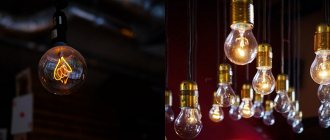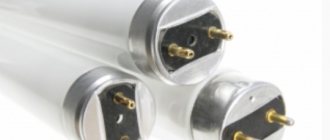How lighting affects vision and mood
Cold light tones, warm light soothes.
As for the effect on the human central nervous system, different shades of lamps (cold, neutral, warm) work like this:
- Cold - invigorates, tones, increases concentration.
- Neutral - almost equal to daylight, therefore does not have a significant effect on the central nervous system.
- Warm - relaxes, creates a feeling of peace, comfort, softness.
Not a single shade of the lamp has a negative effect on the eyes. The exception is flickering light. It provokes increased tension in the visual organs when a person is at rest and when performing work that requires increased concentration: reading, watching TV, manicure, sewing, etc.
Additionally, shades of light can change the colors of surrounding objects - making them more muted or, on the contrary, brighter. Incandescent light can enhance all warm colors. Cold lighting also works in relation to related shades. Therefore, it is advisable to choose interior items and furniture for the house at the level of lighting that prevails in the desired room. Otherwise, unpleasant surprises are possible when arranging what you purchased.
With age, the lens of a person's eye turns slightly yellow. Therefore, all tones and lighting are seen in warmer variations. To correct this perception, you can add a cold lamp to the room.
Warm lighting
Reference . This type of radiation is considered the most comfortable for humans. It promotes rest, relaxation, and helps relieve accumulated irritation.
A suitable place for such lighting is a bedroom, living room, kitchen dining area (or dining room), children's room.
Keep in mind that this spectrum has one more feature: it distorts other shades . You've probably seen that one of your friends thought your dark blue dress was black. In daylight such a mistake would not have happened. Distortion is also possible with other colors. Therefore, it will not be possible to accurately select shades in such lighting.
What is color temperature
Any shade of light has its own color temperature. It is measured in kelvins (K). The scale from left to right starts at 800 K and ends at 20,000 K. The higher the Kelvin level, the cooler the lighting level. The indicator 800 K corresponds to the dim glow of a red-hot red body. The maximum parameter of 20,000 K is equal to the color of the sky at polar latitude.
To create artificial lighting, the consumer is mainly offered lamps with the following color temperature:
- 2700-3000 K. This is a standard incandescent lamp with a tungsten filament that provides warm light in the room.
- 4000-4100. This is neutral light, almost completely replicating daylight.
- 5000-6500 K. Cold shades of the lamp with an admixture of blue.
As a rule, on boxes with energy-saving light bulbs this parameter is marked in a visible place by the manufacturer.
Neutral lighting
In addition to sources of cold and warm radiation, you can choose an option with neutral light . It is also called "natural white".
Reference. The value of such light is that it allows you to perceive other colors with virtually no distortion.
This is especially important for those who do needlework or work with small parts. And it’s just much more pleasant to read in such lighting.
What is better for a person: warm or cold light
The best option is a combination of all types of lighting in the room, which can be controlled as needed. For work that requires concentration, make the cold light lamp more intense; for relaxation in the evening, focus on warm shades of lighting.
Natural white light (neutral)
The most optimal option for illumination of working and living spaces. Such light bulbs do not distort the perception of interior items, do not change the color scheme and do not have a significant impact on a person’s mood. It is better to place such points of artificial light in the living room, children's room, hallway, bathroom, kitchen.
Neutral lighting around a woman’s dressing table is especially important.
Warm light
This type of lighting is more often used in residential areas. In accordance with the original shade of the interior item, under warm lamps the following change occurs:
- Blue - loses intensity, becomes inexpressive, faded.
- Blue - produces greenish tints.
- Purple - transforms into deep shades of red.
- Dark blue (indigo) - changes to black.
In warm lighting, red, orange, brown, yellow, cream colors and other shades from this range look bright and catchy.
Since under the light of a warm lamp a spacious room visually loses its area, it is better to use such lighting only as local lighting. Or place several spotlights under the ceiling around the entire perimeter of the room.
Lamps with a temperature level of 2700-3000 K are ideally combined with all natural materials - wood, cotton, linen, brick, straw, vintage metal. It is good to combine such light with interior styles: modern, Provence, retro, eco, classic, ethnic style. You can connect it to vintage.
At home, the warm light of a light bulb is good to use in the nursery, fireplace room, living room, hallway, and in the bedroom in the form of lamps by the bed.
For public places, lighting in warm colors is good to use in the halls of themed bars, cafes, and restaurants. In boutiques, jewelry stores.
Street lighting with a warm lamp looks good on boulevards, parks, squares with long alleys.
Cold light
This color temperature is recommended for use in office spaces, medical institutions, and laboratories.
Cold lighting visually enhances blue-blue shades, gray, white, steel colors. Warm tones when using such lamps, on the contrary, become muted, distorted, and dull.
Lamps with a cold temperature ideally fit into the interior of rooms with a predominance of geometric shapes, chrome or steel elements. The ideal combination of such lighting is noted with interiors of high-tech, modern, minimalism, futurism, Scandinavian and classical styles.
At home, it is better to use cold light as local light or only in the bathroom, in the kitchen work surface area.
For public places, energy-saving lamps with this color temperature are applicable in classrooms, offices, and warehouses. For street lighting, cold light lamps are installed on highways, stadiums, hangars, and production areas.
Advantages and disadvantages of yellow and white lighting
For greater convenience, it is better to display all the information in tabular form.
| Category | pros | Minuses |
| Warm | Creating a cozy, relaxing environment. Minimal impact on the eyes. Better perception by the body. Smooth color transitions. | Low power. Inability to illuminate a large area. Soft color distortion. |
| Cold | Supports brain and physical activity. Invigorating “morning” effect. Emphasizing progressiveness. More contrasting color reproduction. | Causing rapid fatigue from reading and working with small objects. Creating an uncomfortable atmosphere that requires constant concentration and composure. |
Advice! Professionals advise combining lighting, adjusting light sources to meet your requirements. You need to work - activate the cold light, want to relax - warm it.
Adjustable lamps allow you to control the color of the lighting
The given negative characteristics can be leveled out if used correctly. For example, for street lighting it is better to use:
- A yellow shade for the area in front of the house, an open establishment, a cultural park or just a public garden.
- A bluish tone on roads, gas stations and parking lots (all places where vehicles appear); at stadiums and sports complexes (except for yoga studios); for economic purposes.
Architects mix light sources to highlight certain details in a building.
How to choose a lamp for your home
To choose a light bulb for use in one of the rooms, you need to be guided by the following criteria in addition to color temperature:
- Operating principle. These include standard incandescent, LED, halogen, and fluorescent lamps. The latter are less suitable for use at home because they flicker strongly and have a very high color temperature. LED elements do not have a significant impact on the eyes or interior items, since they are local (point) lighting elements.
- Efficiency LEDs come first here. The last one has incandescent lamps.
- Color rendering index. Marked as Ra. An indicator from 83 to 100 is considered optimal. The higher it is, the less colors will be distorted when illuminated by such a lamp.
- Type of flask. It can have the shape of a spiral, pear, candle, tube, ball, etc. You can determine the required shape by the type of floor lamp/lampshade (open, closed).
- Price. Incandescent lamps are considered the cheapest. The most expensive are energy-saving ones. But the price of such elements is fully compensated by the low power consumption.
How much to spend on an element is determined by each master for himself.
Lamps with different color temperatures in the same room
The main prohibition on using cold and warm lamps is screwing them into one chandelier. Otherwise, you can combine different color temperatures, but follow these recommendations:
- In living rooms, the top (main) type should always be warm or neutral white light.
- If you want to combine different levels of lighting, warmer sources are made below the ceiling level in the form of spotlights, sconces, and floor lamps. They can be turned on in the evening during family holidays and dim other lighting levels.
- It is allowed to install different lamps in the same room if the first ones work as the main source of light, and the second ones as an accent light source. An example is local spotlights over paintings, panels, and figurines.
- Different color temperatures are combined so that the rays of the lamps used never intersect.
- A combination of cold and neutral white light looks good.
It is undesirable to simultaneously turn on both types of different lighting, which can differ greatly from each other.
We combine
Modern interior projects cannot do without several lighting scenarios. It is possible and necessary to use different light temperatures for them. For example: general lighting in the kitchen and local lighting above the dining area can be warm, and the lighting on work surfaces can be white. Neutral light will say more about the quality of your products than a flattering, warm light.
For general lighting in the living room, neutral light is also often chosen, but let sconces, floor lamps and table lamps shine warmly, intimately.
Even one lighting device can combine different lamps: with “morning” and “evening” light, which can be activated using different switch keys.
The bathroom needs honest white light for beauty treatments, but if you completely flood the “ceramic” room with cool light, it can resemble an operating room. To make the environment more relaxing, you can use several lighting scenarios with different temperatures in the bathroom: warm for relaxing in a bubble bath, cold for a vigorous shave or applying makeup in the morning. You can even use two temperatures to illuminate the mirror: for morning and evening makeup.
Which light is best for a room: warm, cold or a combination of both will depend directly on its functional purpose and your habits.
It is advisable not to use warm and white light sources at the same time; this will most likely cause visual dissonance, because on the one hand there will be a signal “it’s time to cheer up”, and on the other - “it’s time to relax”. With such light variations, the body gets tired faster.
LED lighting in the interior of the apartment
New technologies make it possible to realize dreams of the future in design or combine them with classic design.
LED lighting in the interior of an apartment can be reminiscent of high technology or emphasize aristocratic luxury. It can set you in a serious, businesslike mood or create a feeling of lightness and soaring. The temperature of light is as important a part of interior design as the choice of colors, furniture and materials. The Lanskoy TC showrooms will help you choose the right lighting fixtures.
#How to choose #Which is better #Color #Light
What light do you need for reading?
For long reading, doctors recommend combining the main and local types of lighting in the room. At the same time, their color temperatures should not have sharp changes. This has a beneficial effect on the eyes. If you use only local light (a table lamp), it is difficult to achieve the desired level of uniformity in illumination of a book. The organs of vision suffer from this.
The lamp must be placed above the book so that it does not produce glare or shadows. The light intensity level should be medium. Very bright or weak colors strain the eyes.
It doesn’t matter whether the light is warm or cold. The main thing is that both sources (main and local) do not differ (they are either cold or warm).
Color rendering index (CRI or Ra)
The color rendering index refers to the quantitative ability of a lamp to correctly display colors in the interior. In English it sounds like “color rendering index” or simply “CRI” (Ra). The latter type of marking is often affixed to the product box.
The Ra value is calculated on a scale from 1 to 100, where 1 is the worst color reproduction with distortion, and 100 is the most accurate. A value between 80 and 100 is comfortable for the human eye.
The following Ra indicators are typical for different types of lamps:
- incandescent - 80;
- cheap fluorescent - 60-70 Ra;
- models from well-known manufacturers - 70-90;
- LED sources - from 80 or more;
- halogen - close to 100 Ra.
When choosing a light bulb for your home, always pay attention to the Ra level. Fundamental differences in this indicator in two neighboring elements lead to the predominance of the worst of them.











